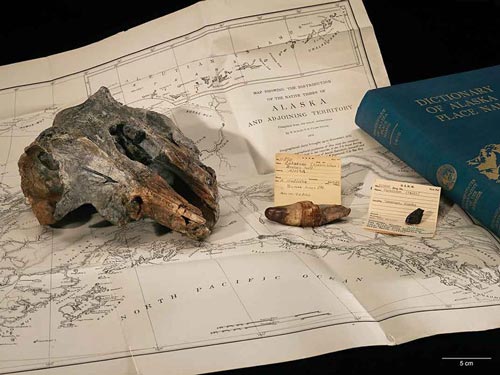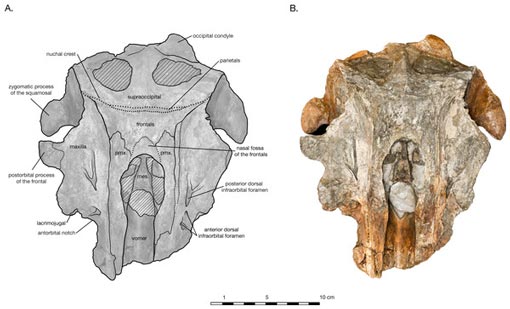New Species of Ancient Dolphin Hiding in a Museum Collection
Arktocara yakataga – May Hold Key to Freshwater Dolphin Evolution
Back in the early fifties, when geologist Donald J. Miller (United States Geological Survey), was mapping the area of Alaska that would eventually become Yakutat City, he came across an ancient skull of a whale. The snout had been broken off and lost but the preserved cranium led to the conclusion that the cranial material and associated teeth belonged to an ancient dolphin. The fossils were despatched to the Smithsonian’s National Museum of Natural History, where they remained until a newly published study revealed their significance.
For models of sea monsters including prehistoric cetaceans: Models of Sea Monsters.
A New Species of Prehistoric Dolphin
The fossils represent a new species of prehistoric dolphin, an animal that lived around twenty-five million years ago and it represents the most northerly specimen of this type of toothed whale ever found. The genus name translates from the Latin as “Face of the North” a reference to the high latitude location of the fossil discovery and the fact that the skull has been designated the holotype.
A Line Drawing (A) and a View of the Fossil Skull (B)
Picture credit: James Di Loreto, Smithsonian Institute
Ancient Dolphin Fossil
Published in the academic journal “PeerJ”, palaeontologists Nicholas Pyenson and Alexandra Boersma describe the fossils and place it within the toothed-whale group, specifically the Platanistoidea. Ironically, the only extant members of this group are confined to freshwater river systems, but the fossil record indicates that these types of dolphins evolved in marine environments. The scientists hope that this new fossil discovery, a specimen that had languished in the Smithsonian fossil collection for more than half a century, will help to shed light on the phylogeny of the Platanistoidea as well as assisting in the research to determine how these particular toothed whales evolved.
Alex Boersma, currently based at the California State University, commented:
“It’s a lovely skull, which is probably the first thing I noticed about it”.
The Skull and Other Fossil Elements

The fossil Arktocara yakataga (resting on an 1875 ethnographic map of Alaska) belonged to a dolphin that swam in subarctic marine waters around 25 million years ago.
Picture credit: James Di Loreto, Smithsonian Institute
The researchers are confident that more strange cetacean skulls may be awaiting discovery in northern latitudes and Alex is sure that this specimen “could answer questions about how this once cosmopolitan group dating back over twenty million years dwindled down to just a few freshwater species.”
The Poul Creek Formation
The fossil comes from the Poul Creek Formation, but the exact location remains unknown, however, the scientists estimate that the fossil dates from between 29 and 24 million years ago, an important period in the history of whale evolution as the two main groups the toothed-whales “Odontoceti” and the baleen whales “Mysticeti” were diversifying and radiating into a number of new genera.
Measuring a little under two and a half metres in length, Arktocara yakataga was about the size of a modern Common Bottlenose Dolphin (Tursiops truncatus). Although the scientists cannot be absolutely certain where the animal died, after all, bones can be transported considerable distances prior to burial and fossilisation, it seems reasonable to assume that this mammal did live in a marine environment. The research team stress that many other types of important fossil may be lingering within the collections of museums, their significance having not yet been realised due to incorrect labelling or inaccurate classification.
An Illustration of Arktocara yakataga
Picture credit: Linocut print art by Alexandra Boersma
To read a recently published article about the origin of high frequency hearing in whales: How High Frequency Hearing in Whales May Have Evolved.



